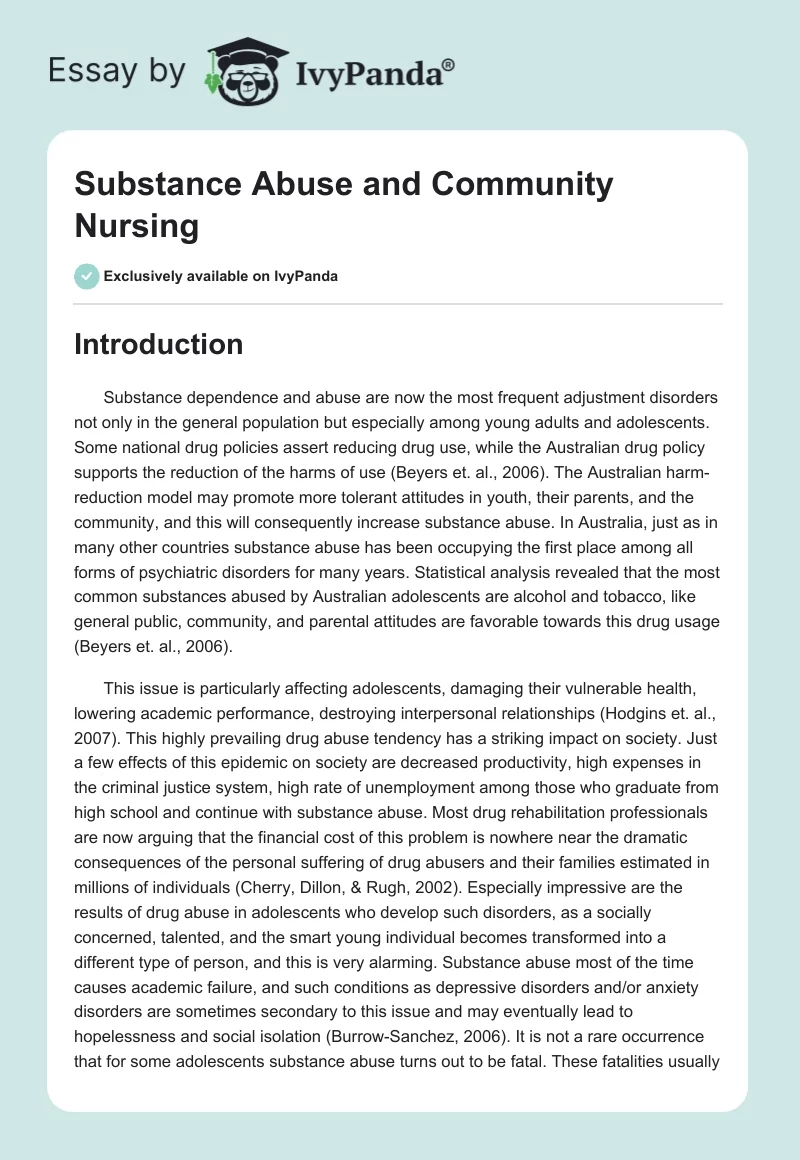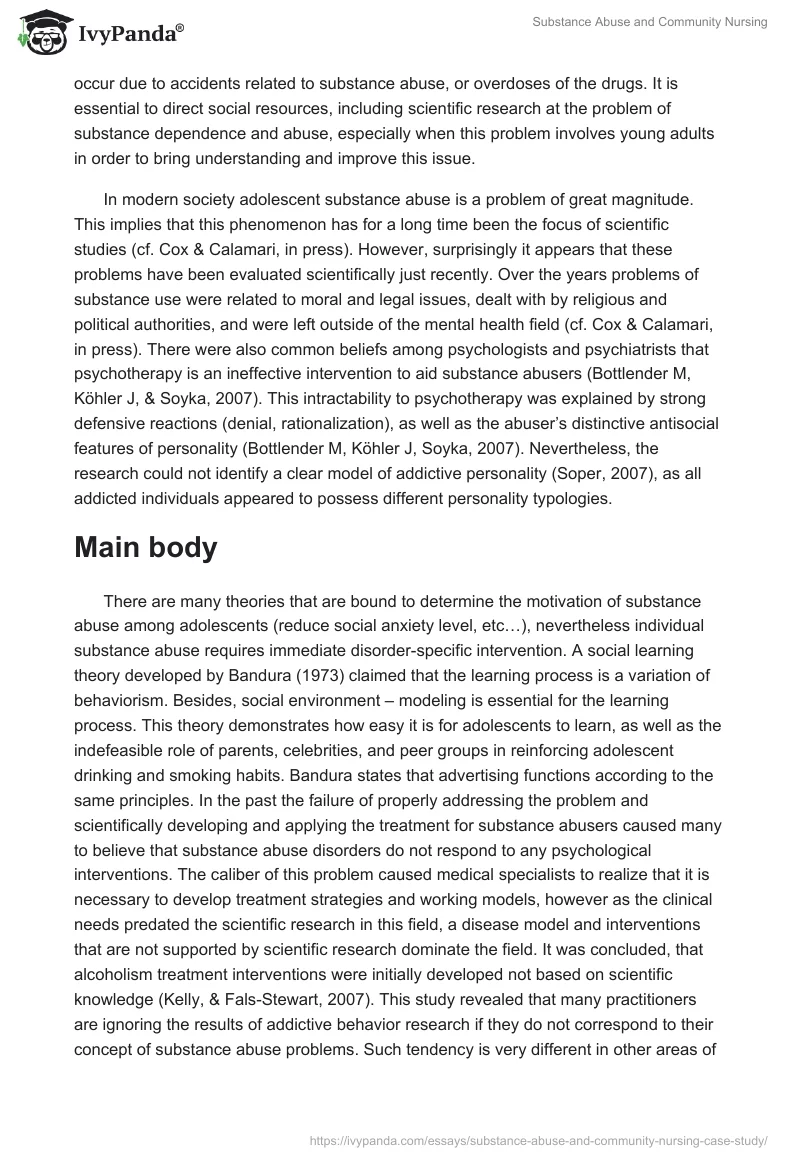Introduction
Substance dependence and abuse are now the most frequent adjustment disorders not only in the general population but especially among young adults and adolescents. Some national drug policies assert reducing drug use, while the Australian drug policy supports the reduction of the harms of use (Beyers et. al., 2006). The Australian harm-reduction model may promote more tolerant attitudes in youth, their parents, and the community, and this will consequently increase substance abuse. In Australia, just as in many other countries substance abuse has been occupying the first place among all forms of psychiatric disorders for many years. Statistical analysis revealed that the most common substances abused by Australian adolescents are alcohol and tobacco, like general public, community, and parental attitudes are favorable towards this drug usage (Beyers et. al., 2006).
This issue is particularly affecting adolescents, damaging their vulnerable health, lowering academic performance, destroying interpersonal relationships (Hodgins et. al., 2007). This highly prevailing drug abuse tendency has a striking impact on society. Just a few effects of this epidemic on society are decreased productivity, high expenses in the criminal justice system, high rate of unemployment among those who graduate from high school and continue with substance abuse. Most drug rehabilitation professionals are now arguing that the financial cost of this problem is nowhere near the dramatic consequences of the personal suffering of drug abusers and their families estimated in millions of individuals (Cherry, Dillon, & Rugh, 2002). Especially impressive are the results of drug abuse in adolescents who develop such disorders, as a socially concerned, talented, and the smart young individual becomes transformed into a different type of person, and this is very alarming. Substance abuse most of the time causes academic failure, and such conditions as depressive disorders and/or anxiety disorders are sometimes secondary to this issue and may eventually lead to hopelessness and social isolation (Burrow-Sanchez, 2006). It is not a rare occurrence that for some adolescents substance abuse turns out to be fatal. These fatalities usually occur due to accidents related to substance abuse, or overdoses of the drugs. It is essential to direct social resources, including scientific research at the problem of substance dependence and abuse, especially when this problem involves young adults in order to bring understanding and improve this issue.
In modern society adolescent substance abuse is a problem of great magnitude. This implies that this phenomenon has for a long time been the focus of scientific studies (cf. Cox & Calamari, in press). However, surprisingly it appears that these problems have been evaluated scientifically just recently. Over the years problems of substance use were related to moral and legal issues, dealt with by religious and political authorities, and were left outside of the mental health field (cf. Cox & Calamari, in press). There were also common beliefs among psychologists and psychiatrists that psychotherapy is an ineffective intervention to aid substance abusers (Bottlender M, Köhler J, & Soyka, 2007). This intractability to psychotherapy was explained by strong defensive reactions (denial, rationalization), as well as the abuser’s distinctive antisocial features of personality (Bottlender M, Köhler J, Soyka, 2007). Nevertheless, the research could not identify a clear model of addictive personality (Soper, 2007), as all addicted individuals appeared to possess different personality typologies.
Main body
There are many theories that are bound to determine the motivation of substance abuse among adolescents (reduce social anxiety level, etc…), nevertheless individual substance abuse requires immediate disorder-specific intervention. A social learning theory developed by Bandura (1973) claimed that the learning process is a variation of behaviorism. Besides, social environment – modeling is essential for the learning process. This theory demonstrates how easy it is for adolescents to learn, as well as the indefeasible role of parents, celebrities, and peer groups in reinforcing adolescent drinking and smoking habits. Bandura states that advertising functions according to the same principles. In the past the failure of properly addressing the problem and scientifically developing and applying the treatment for substance abusers caused many to believe that substance abuse disorders do not respond to any psychological interventions. The caliber of this problem caused medical specialists to realize that it is necessary to develop treatment strategies and working models, however as the clinical needs predated the scientific research in this field, a disease model and interventions that are not supported by scientific research dominate the field. It was concluded, that alcoholism treatment interventions were initially developed not based on scientific knowledge (Kelly, & Fals-Stewart, 2007). This study revealed that many practitioners are ignoring the results of addictive behavior research if they do not correspond to their concept of substance abuse problems. Such tendency is very different in other areas of medicine, where scientific research findings stimulate significant rapid clinical practice changes.
There are various ways for educational institutions to address issues of possession, use, and abuse of substances. These include educational programs, treatment programs, as well as counseling interventions (Harrow et al., 2006). However, these policies will be ineffective unless combined with a precise institutional policy on substance use. The development of policies is an integral part of a straightforward substance abuse prevention and education program. Such policy should help to determine the boundary between the end of the school policy and the beginning of the student responsibility, as well as be clearly visible and well-enforced, aiming at decreasing substance abuse among adolescents.
My substance abuse policy package includes the next features: it corresponds with the law, promotes a drug-free environment, defines the target category, identifies prohibited behaviors, establishes protocols that involve police officers, refers affected individuals to counseling, and rehab assistance sources. Many institutional policymakers do not have much knowledge concerning conditions and factors that influence policy development. Each substance abuse policy should include its own philosophy and institutional mission, legal landscape, including law principles with examples of relevant court cases. It must also mention the objectives of the institution in the development of the policy, as well as educational perspectives on abuse, possession, and addiction of various substances.
While efforts aimed at increasing substance abuse awareness among adolescents have been made, this issue continues to progress at a disturbing rate. Most known data concerning the rate and problem of substance abuse among the young population is obtained from the survey data, and most drug abuse cases are not treated, as they go undetected. Identification of such problems, followed by assessment and treatment is of significant concern for all professionals somehow involved in working with this age group, however, most school personnel are still unclear on the best way to intervene on behalf of the student. School personnel plays a vital role in the general assessment of substance abuse among their students. It is important for them to realize the need and feel secure about referring students for alcohol and drug assessment. It is also significant for the people working with adolescents to identify those students who may need such assessment according to the most basic warning signs and factors. Implementation of the assessment referring process is also required, and school staff may need special training in order to do so, and be able to do a follow-up on the assessment.
In order to evaluate the results of the implemented policy, the levels of substance abuse among the adolescent population should be continuously monitored. This could be done using questionnaires that include the true-false question, are highly valid and reliable. The items in the questionnaire should measure negative consequences of substance abuse: symptoms of abstinence, blackouts, and dependence. The questions must focus on assessing the time when the problems have occurred in the lifetime of a student, as well as their frequency and severity. Such tests should identify those adolescents, who experience multiple consequences of substance abuse, and those ones with the most severe consequences, individually specifying measures of prevention and intervention. This test must be used as an instrument for screening that helps to identify intervention areas, as well as obtaining descriptive information. In order to prevent misdiagnosing substance abusers a special type of scoring should be used for each situation. The questionnaire must also include subtle questions that prevent students from concealing their substance abuse. These questions will reduce the possibility for the students to “fake good” by asking questions that are not directly related to substance use, but refer more to the student’s states of behavior implying to their health status, emotional states, social interaction, needs, preferences, interests, and values.
Conclusion
The importance of screening and early identification of substance use among adolescents is emphasized in this policy package as it is essential for preventing and minimizing negative medical, social, and economic consequences for the young population. The assessment of substance abuse among adolescents must focus on determining what the problem is, and afterward characterizing the abuse problem, rather than evaluating whether the abuser fits into a definition of what is considered problematic. Therefore, the evaluation tools are implemented not just for screening, but also for a better understanding of each substance abuse case. Generally, the optimal way of assessing a substance abuse case is when the evaluator is using basic background information, previous abuse history, patterns of abuse, mental health concerns of the subject, as similar problems within the family. The assessor must consider all risk factors and develop a risk profile based on the obtained information, as well as attempt to understating the present behavior of the person, in terms of what currently goes on in his life. The motivational, cognitive, and emotional components are also of great significance, as they contribute to the present behavior.
References
Bandura, A. (1973). Aggression: A Social Learning Analysis. Englewood Cliffs, NJ: Prentice-Hall.
Beyers, J.M., Toumbourou, J.W., Catalano, R.F., et al. (2004) A cross-national comparison of risk and protective factors for adolescent substance use: the United States and Australia. J. Adolesc Health, 35(1), 3-16.
Bottlender, M., Köhler, J., Soyka, M. (2006). The effectiveness of psychosocial treatment approaches for alcohol dependence—a review. Fortschr Neurol Psychiatr, 74 (1),19-31.
Burrow-Sanchez, J. J. (2006). Understanding Adolescent Substance Abuse: Prevalence, Risk Factors, and Clinical Implications. Journal of Counseling and Development, 84(3), 283+.
Cherry, A., Dillon, M. E., & Rugh, D. (Eds.). (2002). Substance Abuse: A Global View. Westport, CT: Greenwood Press.
Cox W. M., & Calmari J. E. (in press). Addiction. Encyclopedia of human biology (2nd ed.). San Diego, CA: Academic Press.
Harrow, B. S., Tompkins, C. P., Mitchell, P. D., Smith, K. W., Soldz, S., Kasten, L., et al. (2006). The Impact of Publicly Funded Managed Care on Adolescent Substance Abuse Treatment Outcomes. American Journal of Drug and Alcohol Abuse, 32(3), 379+.
Hodgins, S., Tengström, A., Bylin, S., Göranson, M., Hagen, L., Janson, M., Larsson A., Lundgren-Andersson, C., Lundmark, C., Norell, E., Pedersen, H. (2007). Consulting for substance abuse: Mental disorders among adolescents and their parents. Nord J. Psychiatry, 61 (5), 379-86.
Kelley, M.L., Fals-Stewart, W. (2007). Treating paternal alcoholism with learning sobriety together: effects on adolescents versus preadolescents. J. Fam Psychol 21(3),435-44.
Soper, R. G. (2007). Addiction–chronic disease or character defect? Tenn Med100 (8), 9-11.


